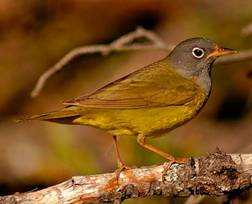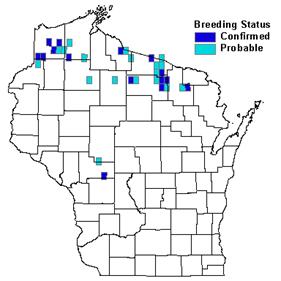Photo by Dennis Malueg


Status/Protection
- Global Rank: G4 Key to global and state ranks
- State Rank: S2S3B
- WBCI Priority: SGCN, PIF, State Special Concern
Population Information
Federal BBS information can be obtained at http://www.mbr-pwrc.usgs.gov/bbs/bbs.html by clicking on Trend Estimates and selecting the species in question. All estimates are for 1966-2005.
*Note: There are important deficiencies with these data. These results may be compromised by small sample size, low relative abundance on survey route, imprecise trends, and/or missing data. Caution should be used when evaluating this trend.
- Federal Breeding Bird Survey: non-significant decline
- Federal Breeding Bird Survey (WI): non-significant decline
- Federal Breeding Bird Survey (BCR 23): non-significant decline*
- Federal Breeding Bird Survey (BCR 12): significant decline
- Nicolet National Forest Bird Survey (UWGB): significant decline (Howe and Roberts 2005)
- WSO Checklist Project: stable (1983-2007)
Life History
- Breeding Range: Eastern British Columbia east to western Quebec, south into the Minnesota, Wisconsin, and Michigan (Pitocchelli et al. 1997).
- Breeding Habitat: Jack Pine, Swamp Conifer-Balsam Fir, Tamarack, Black Spruce, Pine Barrens, Open Bog-Muskeg.
- Nest: Cup on or near the ground (Ehrlich et al. 1988).
- Nesting Dates: Eggs: June to July (Pitochelli et al. 1997).
- Foraging: Ground glean, foliage glean (Ehrlich et al. 1988).
- Migrant Status: Neotropical migrant.
- Habitat use during Migration: Areas with dense tangles of wet undergrowth; forests, swamps, parks (Pitochelli et al. 1997).
- Arrival Dates: Mid-May to early June.
- Departure Dates: Mid-August to early October (Robbins 1991).
- Winter Range: Northern South America through western Amazon basin (DeGraaf and Rappole 1995).
- Winter Habitat: Forest edges and dense shrubs, rain forest, cloud forest, mesquite (Pitochelli et al. 1997).
Habitat Selection
The Connecticut Warbler primarily inhabits poorly drained areas, including spruce-tamarack forests, wet second-growth forests, and grassy margins along spruce or deciduous forests (Pitochelli et al. 1997). In the Chequamegon National Forest of Wisconsin, the Connecticut Warbler is found almost exclusively in jack pine forests composed of trees at least 4.5 meters in height (Robbins 1974). Elsewhere in the state it occurs in lowland conifer, especially black spruce and tamarack bogs with a good shrub layer (USDA 2002). Forest structure is generally open with a dense shrub and herb layer up to 1 meter high (Binford 1991, USDA 2002). Patch size and other landscape needs are not well known; however, Connecticut Warblers do occur in relatively small bogs (< 40 hectares) and they do not appear to be edge sensitive (USDA 2002). Connecticut Warbler nests on or near the ground, in the thick undergrowth of saplings, clumps of moss, and thickets (Pitochelli et al. 1997).
During migration it uses patches of tall dense herbaceous plants, such as jewelweed, giant ragweed, and cupplant, alder thickets, or other dense, wet, low vegetation. It also can be found in lilacs or other shrubs in parks (Robbins 1991). During winter it frequents a variety of habitats ranging from tropical rain forest in the Amazon basin to cloud forests in South American mountains (Meyer de Schauensee and Phelps 1978).
Habitat Availability
Today the Connecticut Warbler attains its greatest density in the Northwest Sands ecological landscape, where jack pine forests and barrens are still prevalent. Jack pine forests have declined by as much as 79% throughout the Great Lakes region (Snetsinger and Ventura n.d.) and remaining stands face continuing threats. Climate change models predict that jack pine, along with several other habitat types used by Connecticut Warblers, will be extirpated in Wisconsin in less than 200 years (Scheller and Mladenoff 2005). Additionally, red pine plantations continue to replace jack pine forests in many areas of Wisconsin. In an attempt to address this issue, the Chequamegon-Nicolet National Forest has drafted proposed standards and guidelines to prevent all jack pine stands from being converted to red pine and proposes to manage for a possible increase or “no net loss” of jack pine habitat (USDA 2002). If implemented, these actions will likely benefit Connecticut Warbler and many other species associated with jack pine forests.
Elsewhere in Wisconsin, Connecticut Warblers are found uncommonly in large muskegs, spruce bogs, and on the edges of tamarack bogs (Pitocchelli et al. 1997, Robbins 1991). Black spruce and tamarack forests were widespread and relatively common historically, although they did not typically occur in large patches in Wisconsin. These forest types remain relatively common in much of their Wisconsin range today (WDNR 2005). Within the Great Lakes region, however, black spruce and other coniferous lowland forest types may have declined by as much as 15% (Snetsinger and Ventura n.d.).
Population Concerns
Breeding Bird Survey (BBS) data suggest non-significant declines range-wide and in Wisconsin (Sauer et al. 2005). However, BBS trends for Connecticut Warbler are difficult to interpret due to small sample sizes. Additionally, few nesting records exist for the state. During the six-year period (1995-2000) of the Wisconsin Breeding Bird Atlas, observers confirmed a total of 10 breeding records in Bayfield, Douglas, Forest, Iron, Jackson, Oneida, and Vilas counties (Johnson 2006). Primary threats to this species’ habitat include the loss of jack pine forests and barrens due to woody encroachment in the absence of fire and cover type conversions to red pine plantations (WDNR 2005). The Connecticut Warbler also may be suffering from habitat loss on its wintering grounds but without further study this is difficult to assess. This species is commonly found dead at tower kill sites during migration (Pitocchelli et al. 1997).
Recommended Management
Developing management recommendations for such a poorly studied species is a difficult task. However, management efforts focused on increasing total acreages of jack pine and conifer barrens will likely benefit Connecticut Warblers. Maintaining jack pines habitats with trees at least 4.5 m in height may be important (Robbins 1974). Land managers also should consider using prescribed burning to manage and naturally regenerate northern dry forests where possible (WDNR 2005).
Conservation and management strategies for this species should be focused in the following Wisconsin ecological landscapes: Central Sand Plains, North Central Forest, Northern Highland, Northwest Lowlands, and Northwest Sands (WDNR 2005). Within these landscapes, key conservation sites include Namekagon Barrens, Solon Springs Sharptail Barrens, Buckley Creek and Barrens State Natural Area, Moose Junction Peatlands, and Upper Wisconsin River Wetlands and Pines.
Research Needs
This species is one of the poorest known of all North American passerines. Studies in all aspects of its breeding biology are urgently needed. More research is needed on how various forest management practices impact breeding (WDNR 2005) and on its distribution and ecology on the wintering grounds (Rappole 1995, Pitocchelli et al. 1997). The Connecticut Warbler may be an important species to monitor as an indicator of climate change effects.
Information Sources
- Chequamegon National Forest Bird Survey (NRRI) species account: http://www.nrri.umn.edu/mnbirds/accounts/CONWa2.htm
- Chequamegon National Forest Bird Survey (NRRI) map: http://www.nrri.umn.edu/mnbirds/accounts/conwm2.htm
- Great Lakes Bird Conservation probability map: http://www.uwgb.edu/birds/greatlakes/species/conwmap2.htm
- Nicolet National Forest Bird survey map: http://www.uwgb.edu/birds/nnf/species/CONW.htm
- North American Breeding Bird Survey: http://www.mbr-pwrc.usgs.gov/bbs/bbs.html
- Temple S.A., J.R. Cary, and R. Rolley. 1997. Wisconsin Birds: A Seasonal and Geographical Guide. Wisconsin Society of Ornithology and Wisconsin Department of Natural Resources, Madison, WI.
- Wisconsin Breeding Bird Atlas: http://www.uwgb.edu/birds/wbba/
References
- Binford, L.C. 1991. Connecticut Warbler. In The Atlas of Breeding Birds of Michigan (R. Brewer, G.A. McPeek, and R.J. Adams, Jr., eds.). Michigan State University Press.
- DeGraaf, R.M. and J.H. Rappole. 1995. Neotropical migratory birds: natural history, distribution, and population change. Comstock Publ. Assoc., Cornell Univ. Press, Ithaca, NY.
- Ehrlich, P.R., D.S. Dobkin, and D. Wheye. 1988. The birders handbook: a field guide to the natural history of North American birds. Simon & Schuster, Inc. New York.
- Howe, R.W. and L.J. Roberts. 2005. Sixteen years of habitat-based bird monitoring in the Nicolet National Forest. In C.J. Ralph and T.D. Rich, editors. Bird Conservation Implementation and Integration in the Americas: Proceedings of the Third International Partners in Flight Conference. 2002 March 20-24; Asilomar, California, Volume 2. Gen. Tech. Rep. PSW-GTR-191. Albany, CA: Pacific Southwest Research Station, Forest Service, U.S. Department of Agriculture; 643 p.
- Johnson, R. 2006. Connecticut Warbler. In Atlas of the Breeding Birds of Wisconsin. (N.J. Cutright, B.R. Harriman, and R.W. Howe, eds.) The Wisconsin Society for Ornithology, Inc. 602pp.
- Meyer de Schauensee, R. and W.H. Phelps, Jr. 1978. A guide to the birds of Venezuela. Princeton Univ. Press, Princeton, NJ.
- Pitocchelli, J., J. Bouchie, and D. Jones. 1997. Connecticut Warbler (Oporornis agilis). In the Birds of North America, No. 320 (A. Poole and F. Gill, eds.). The Academy of Natural Sciences, Philadelphia, PA, and the American Ornithologists’ Union, Washington, D.C.
- Rappole, J.H. 1995. The ecology of migrant birds. Smithsonian Institution Press, Washington, D.C.
- Robbins, S.D. 1974. New light on the Connecticut Warbler. Passenger Pigeon 36(3): 110-115.
- Robbins, S. D. 1991. Wisconsin birdlife: population & distribution, past & present. Univ. of Wisconsin Press, Madison, WI.
- Sauer, J.R., J.E. Hines, and J. Fallon. 2005. The North American Breeding Bird Survey, Results and Analysis 1966 - 2005. Version 6.2.2006. USGS Patuxent Wildlife ResearchCenter, Laurel, MD.
- Scheller, R.M. and D.J. Mladenoff. 2005. A spatially interactive simulation of climate change, harvesting, wind, and tree species migration and projected changes to forest composition and biomass in northern Wisconsin, USA. Global Change Biology 11: 307–321.
- Snetsinger, S. and S. Ventura. n.d. Landcover change in the Great Lakes region from mid-nineteenth century to present. Online at http://www.ncrs.fs.fed.us/gla/
- USDA. 2002. Conservation assessment for Connecticut Warbler. USDA Forest Service, Eastern Region. 46pp. http://www.fs.fed.us/r9/wildlife/tes/ca-overview/docs/bird_Oporornis_agilis-ConnecticutWarbler.pdf
- Wisconsin Department of Natural Resources (WDNR). 2005. Wisconsin’s Strategy for Wildlife Species of Greatest Conservation Need. Madison, WI.
Contact Information
- Compiler: William P. Mueller, iltlawas@earthlink.net
- Editors: Kim Kreitinger, K.Kreitinger@gmail.com | Randy Hoffman, Randolph.Hoffman@Wisconsin.gov
